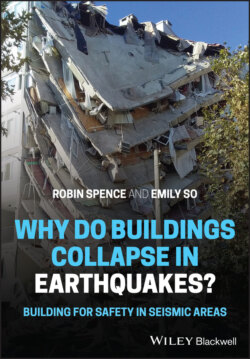Читать книгу Why do buildings collapse in earthquakes? Building for safety in seismic areas - Robin Spence - Страница 14
1.5 Outline of the Book
ОглавлениеThe remainder of the book is divided into eight chapters. Chapter 2 presents field evidence of how buildings behave in earthquakes. It discusses how post‐earthquake field investigations have contributed to our understanding of building behaviour. It gives brief accounts of 10 of the most significant earthquakes of the past 20 years. It concludes with an assessment of the overall trends of earthquake damage and casualties over time, and their distribution between richer and poorer countries.
Chapter 3 looks at how buildings are constructed in the world's most earthquake‐prone regions. It considers first how the local climate affects local patterns and traditions of building, and shows how those traditional building forms affect earthquake performance. The world's areas of the greatest earthquake risk are then subdivided into 10 separate zones, and the patterns of building typical of each are described and illustrated, distinguishing rural and urban types.
Chapter 4 explains what causes earthquakes, and shows how the ground motions caused by them are felt by buildings and how buildings respond. It also considers other ways in which earthquakes can affect buildings through ground deformation, landslides, tsunamis and fire outbreaks, and points to the growing risk of compound disasters triggered by earthquakes.
Chapter 5 considers how buildings of different types of construction respond to the principal earthquake hazard of ground shaking. It classifies buildings into their different types and subtypes according to the main material of the load‐resisting system – masonry, reinforced concrete, timber and steel. For each main type, it describes the typical behaviour in an earthquake from the onset of damage to collapse, based on field observations. And it suggests cost‐effective ways in which each type of building could be made more earthquake‐resistant. Chapter 5 also compares the earthquake vulnerability of different building types, showing the wide disparities that exist within the global building stock.
Chapter 6 looks at human casualties caused by earthquakes. It identifies the main causes of casualties, and how these relate both to building performance and to occupant behaviours. It shows how the expected number of casualties from a particular earthquake can be estimated for loss modelling, using either statistical or engineering approaches.
Chapter 7 considers different routes by which the earthquake resistance of buildings can be improved. It looks first at the engineering design of buildings and how codes of practice are used to achieve acceptable safety levels, both in the construction of new buildings and in the strengthening of existing buildings, and discusses associated costs. It also considers limitations in the effectiveness of building control regulations and implementation of codes of practice, and describes how building for safety programmes have been used to improve the construction of non‐engineered building in poorer countries.
Chapter 8 reports on a global survey of the successes and failures of earthquake protection, country by country, based on responses from 39 experts in 28 different countries. For each responding country, the identified successes and failures are examined, and the countries are divided into three groups ‘high achievers’, ‘limited achievers’ and those with ‘continuing and growing risks’, indicating the wide disparity of performance across the world.
What is technically possible will only be achieved by the action of individuals and society as a whole, and its institutions. Thus, Chapter 9 concludes the book with an examination of what part different organisations and groups of people can play in meeting the overall challenge of earthquake protection. The separate roles of governments (national and local), non‐government organisations (NGOs), the scientific and professional community, businesses, homeowners and individual citizens and the insurance industry are considered, and suggestions are made for ways in which each group could act more effectively.
Emphasising the message that it is ultimately the action of individuals that counts, the book contains a series of profiles (located as boxes within the appropriate chapters) of some individuals – ‘game‐changers’ – whose actions have made a notable contribution to earthquake protection in their particular situation. These advocates show what we can do with the knowledge to build safe buildings before an earthquake strikes and to stop preventable deaths. Earthquakes are an underrated hazard: but by ensuring safe buildings and earthquake awareness before the earthquakes strike, we can make the threat unremarkable.
